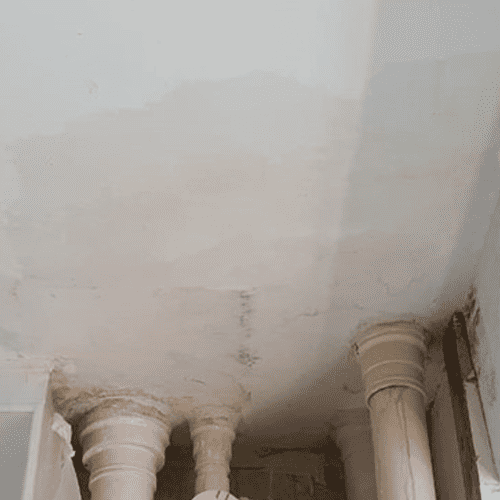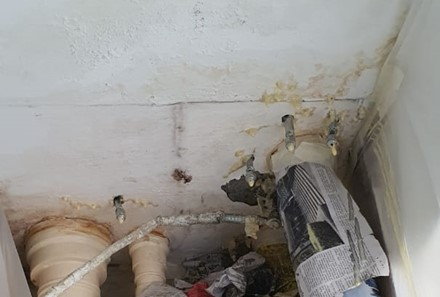One of the most common and frustrating problems many homeowners face is ceiling water leaks. The relentless tropical climate and the constant wear and tear on our buildings can lead to unexpected leaks that seem to come at the worst times. In Singapore, where humidity and wear are prevalent, toilet ceiling water leaks can be disruptive.
Let’s dive into the world of ceiling water leaks in Singapore to equip you with the knowledge you need to address them effectively. There are a range of repair methods, including non-hacking solutions like epoxy injection and chemical grouting.
Causes of Toilet Water Leaks
Toilet ceiling water leaks can be caused by a variety of factors, but some of the most common culprits include:
Pipe damage: Over time, plumbing pipes can deteriorate or become damaged, leading to leaks.
Wear and Tear: Singapore’s high humidity levels and frequent use of toilets can contribute to wear and tear on plumbing fixtures and ceilings.
Structural Issue: Faulty building structures can also be a root cause of ceiling leaks.
Neighboring Units: Leaks from upper units or adjacent bathrooms can seep into your ceiling, causing water damage.
These causes underscore the importance of addressing toilet ceiling water leaks promptly. Ignoring them can result in extensive damage to your property and even pose health risks due to mold growth.
Troubleshooting Leaks from Upper Units
When dealing with ceiling water leaks, it’s essential to troubleshoot effectively, especially if the source of the leak is an upper unit. Here’s what you can do:
1. Visual Inspection:
Look for visible signs of leakage from the upper unit, such as damp spots, water stains, or dripping water.
2. Communicate:
Contact the resident in the upper unit if possible, inform them of the issue, and request their cooperation in identifying and fixing the leak.
3. Engage a Professional Contractor:
Hire a professional waterproofing contractor to inspect the upper unit’s fixtures and identify any issues. Document any findings such as leak detection reports, especially if you will need to engage in discussions with the upper unit’s resident or property management.
Ways to Fix the Leaking Ceiling
When it comes to repairing a leaking ceiling, there are various methods and solutions available in Singapore. Each approach has its pros and cons. For minor leaks or cosmetic issues, a simple patch and paint job may suffice. This involves repairing the affected area and repainting the ceiling.
Waterproofing is a crucial step to prevent future leaks. It involves applying waterproofing membranes or coatings to the affected area to create a barrier against water intrusion.
If the leak is caused by damaged or corroded pipes, a plumber may need to replace or repair the faulty plumbing components.
In severe cases where the ceiling is extensively damaged, a complete ceiling replacement may be necessary.
Selecting the appropriate repair method depends on the extent of the damage, the cause of the leak, and your budget. Consulting with professionals is essential to assess the situation and determine the best course of action.
Professional Non-Hacking Repair Methods in Singapore
In Singapore, homeowners are often concerned about the invasive nature of repair work. Non-hacking repair methods offer less intrusive solutions. Here are some non-hacking repair options.
- PU injection Grouting is a non-invasive method used to seal cracks and leaks in concrete structures. It’s effective for waterproofing and can be applied to ceilings without major disruption. Chemical grouting involves injecting specialized chemicals into cracks and voids to seal leaks and strengthen the structure. It’s a minimally invasive solution.
- Waterproofing membranes, when applied correctly, create a seamless barrier against water penetration. They can be used without extensive hacking or demolition.
These non-hacking methods offer the advantage of preserving the integrity of your ceiling and reducing the need for extensive repairs.
Who to Call for Carrying Out the Repair Works
Choosing the right professionals to carry out repair work is essential for a successful outcome. Here’s how to find the right experts:
Licensed Contractors: Ensure that the professionals you hire are licensed and experienced in handling ceiling water leak repairs.
Ask for Recommendations: Seek recommendations from friends, neighbors, or online forums for trustworthy plumbers or waterproofing contractors.
Review Contracts: Carefully review contracts to understand the scope of work, timelines, and payment terms.
Choosing the right professionals can make a significant difference in the success of your ceiling water leak repair project.
The best waterproofing solutions for repair works
Understanding the available solutions for repair work is crucial for making informed decisions.
To determine the most suitable solution for your specific situation, it’s essential to consult with professionals who can assess the extent of the damage and recommend the appropriate repair method.
Non-hacking repair methods have gained popularity in Singapore due to their minimally invasive nature. A non-hacking repair method commonly used for sealing cracks and leaks in concrete ceilings.
Chemical grouting is another non-invasive technique used to seal leaks. It involves injecting chemical grout into the affected areas such as cracks, voids, or gaps. The chemical grout expands and solidifies, creating a waterproof barrier. It also strengthens the structural integrity of the ceiling.
PU Injection grouting
Polyurethane injection grouting is a widely used technique in waterproofing work for various applications. It involves injecting a liquid polyurethane resin into cracks, joints, or voids in structures to seal them and prevent the passage of water. Here are some of the key benefits and uses of polyurethane injection grouting for waterproofing:
- Sealing Cracks and Joints:
Polyurethane injection grouting is highly effective in sealing cracks and joints in concrete, masonry, or other construction materials. It can fill even narrow or inaccessible cracks, preventing water infiltration.
- Flexible Seal:
Polyurethane grout forms a flexible seal that can accommodate slight movements or structural shifts without losing its effectiveness. This flexibility is crucial in preventing re-cracking due to temperature changes or settling.
- Rapid Curing:
Polyurethane grouts typically cure quickly, reducing downtime for construction or repair projects. This rapid curing minimizes disruptions and allows for faster completion of waterproofing work.
- High Water Resistance:
Once cured, polyurethane grouts create a durable and waterproof barrier. They can withstand exposure to water, chemicals, and environmental factors, making them suitable for various applications and sealing water leaks.
- Cost-Effective:
Polyurethane injection grouting can be a cost-effective solution compared to other waterproofing methods, especially for repairing specific problem areas rather than implementing extensive waterproofing systems.
- Minimally Invasive:
It is a minimally invasive technique that doesn’t require extensive excavation or disruption of the existing structure. This makes it particularly useful for repairing existing structures without causing significant damage.
- Versatility:
Polyurethane injection grouting is versatile and can be used in a wide range of waterproofing applications, including basements, tunnels, foundations, retaining walls, and concrete structures. It can also be used to stabilize soils and fill voids.
- Longevity:
When properly applied, polyurethane injection grouting can provide long-lasting waterproofing protection. It resists deterioration and maintains its sealing properties over time.
- Environmentally Friendly:
Many polyurethane grouts are formulated to be environmentally friendly, making them a more sustainable choice for waterproofing projects.
It’s essential to note that the success of polyurethane injection grouting depends on proper preparation, application, and selection of the right type of polyurethane grout for the specific project and conditions. Therefore, it’s recommended to consult with experienced professionals in waterproofing and construction to assess your specific needs and ensure a successful waterproofing outcome.
Clear Penetrative Treatment
Clear Penetrative Treatment is a waterproofing membrane that is applied as a continuous layer to create a seamless barrier against water penetration. The membranes are applied to the affected areas, typically without the need for extensive hacking. It protects the ceiling from water intrusion and prevents future leaks.
These non-hacking repair methods offer effective solutions without the disruption of extensive demolition.
Non-hacking waterproofing, also known as surface-applied waterproofing, involves applying a waterproofing membrane or coating directly onto the exterior surface of a structure without the need for extensive hacking or excavation. The choice of a suitable waterproofing membrane for non-hacking applications depends on various factors, including the type of substrate, environmental conditions, and the specific requirements of the project.
Liquid waterproofing membranes are versatile and can be applied directly onto the substrate using rollers, brushes, or spray equipment. They create a seamless and flexible barrier when cured.
Polyurethane liquid membranes are known for their durability, flexibility, and excellent adhesion to various substrates. They are suitable for a wide range of applications, including roofs, decks, and basements.
Proper surface preparation and application techniques are crucial to the success of non-hacking waterproofing projects.
Prevention is often the best strategy when it comes to ceiling water leaks. Conduct regular inspections of your plumbing fixtures, ceilings, and walls for any signs of wear or damage. Address any minor issues promptly before they escalate into major problems. Engage professional contractors to provide waterproofing solutions during construction or renovation to prevent future leaks. Ensure proper ventilation in your bathroom to reduce humidity levels, which can contribute to ceiling damage.
In the bustling urban environment of Singapore, toilet ceiling water leaks are a common issue that homeowners must address promptly. Understanding the causes, taking immediate action, and selecting the right professionals are key steps in resolving these problems effectively. Whether you opt for traditional repair methods or non-hacking solutions, the goal is to restore the integrity of your ceiling and prevent future leaks.
SWC Construction is a professional specialist in waterproofing for commercial, industrial, and residential owners in Singapore. We are a committed, experienced waterproofing contractor who provides our best service to all our potential customers.
Contact us now for a non-obligation thermal image consultation session to understand the condition of the leakage and the best waterproofing solution to resolve all leaks.




